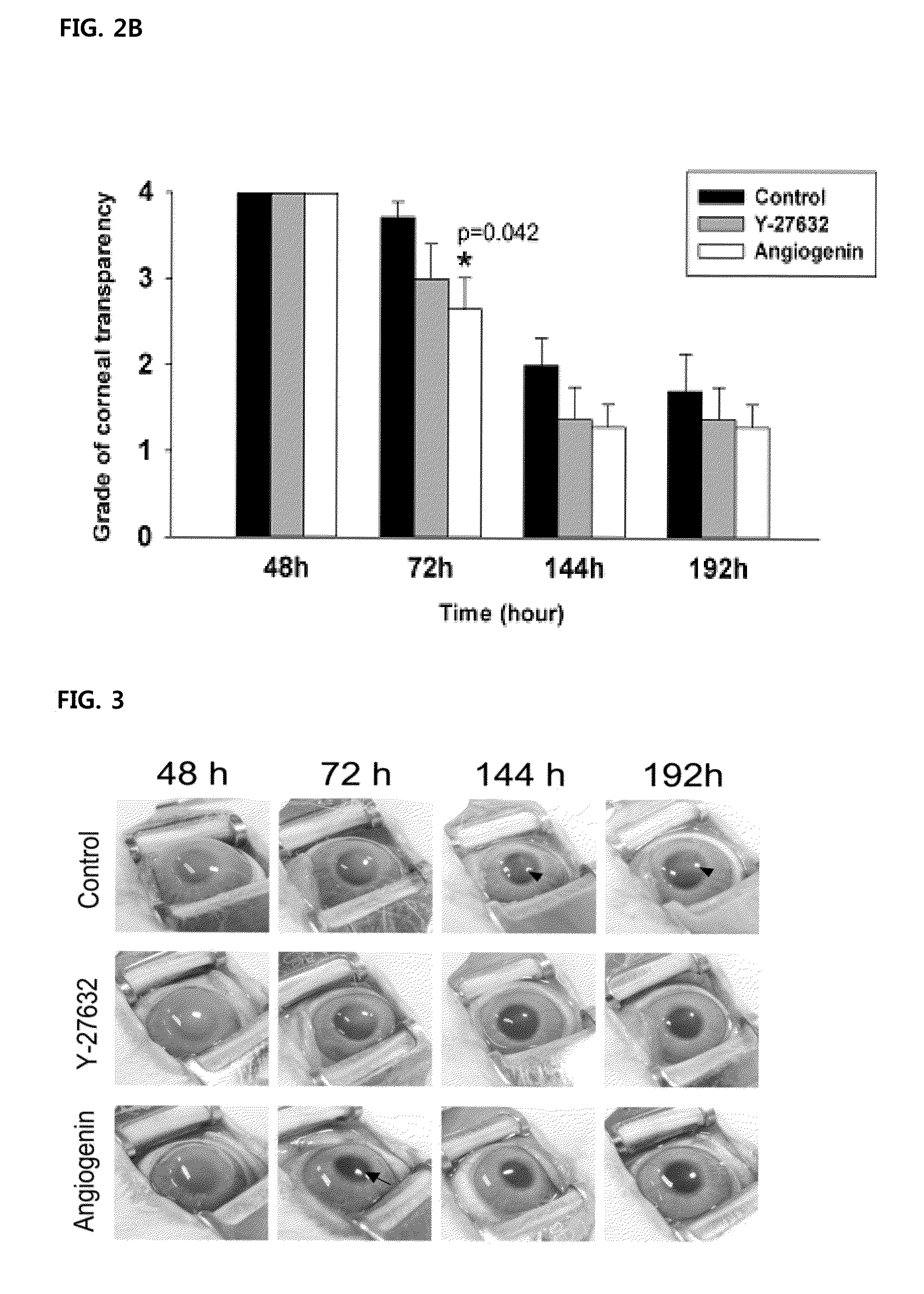Pharmaceutical composition for treatment of corneal endothelial wounds containing angiogenin
an angiogenin and corneal endothelial technology, applied in the field of corneal endothelial wounds, can solve the problems of many difficulties in wound treatment, and achieve the effect of enhancing migration and proliferation of corneal endothelial cells
- Summary
- Abstract
- Description
- Claims
- Application Information
AI Technical Summary
Benefits of technology
Problems solved by technology
Method used
Image
Examples
example 1
Analysis of Wound Healing Effects on In Vivo Corneal Endothelium of Angiogenin
[0046]1. Corneal Endothelium Damages in Eyes of Rabbits
[0047]All experiments were carried out according to the Association for Research in Vision and Ophthalmology (ARVO) guidelines for animal experiments.
[0048]30 eyeballs of 15 healthy white New Zealand rabbits weighing about 2.0 kg to about 3.0 kg without external opacification were anesthetized by intramuscular injection with 12.5 mg / kg of tiletamine / zolazepam (Zoletil®, VirbacLab, France) and 12.5 mg / kg of zylazine (Rompun®, BayerKorea, Korea). Afterwards, 0.5% povidone-iodine was used for disinfection of the whole range of experimental sight. The damage to the rabbit corneal endothelium was induced as shown in FIG. 1. Referring to FIG. 1, an 8 mm-diameter stainless steel rod as a probe was immersed in liquid nitrogen for 3 minutes, removed therefrom once the temperature of the liquid nitrogen reached −196° C., and brought into contact to the central c...
example 2
Analysis of Angiogenin Effects on In Vitro Migration and Proliferation of Corneal Endothelial Cells
[0060]1. Culturing of Rabbit and Human Corneal Endothelial Cells
[0061]A corneal endothelial tissue segment obtained from remaining corneal portions other than the central 8 mm corneal portion in cadaveric cornea donated for transplantation and a corneal endothelial tissue segment of a normal rabbit were cultured. Then, each of the corneal tissues was divided into 6 pieces and washed by shaking 6 times in a petri dish to which 7 ml of 5% penicillin / streptomycin (P / S) was added. Then, the washed tissues were each transferred to a 6-well dish such that the endothelial layer was facing down, and the tissues were semi-dried until the dishes were slightly drained. Next, the corneal endothelial cells of the rabbit cornea were cultured in a culture medium (EGM™-2BulletKit™, Lonza, Allendale, USA) containing human epidermal growth factor (hEGF), hydrocortisone, 5% fetal bovine serum (FBS), huma...
example 3
Identification of Intracellular Pathway of Angiogenin
[0068]1. Analysis of In Vivo Wound Healing Aspects in a Group Given Both LY294002 and Angiogenin Instillations
[0069]Experiments have been carried out to identify effects of angiogenin-induced PI3k-Akt signaling pathway in terms of recovering the corneal transparency after inducing damages to the corneal endothelium. After inducing freeze-damages to the corneal endothelium, 4 eyeballs out of 30 rabbit eyeballs in total were subjected to 50 μl of each of 200 μg / mL of angiogenin and 200 μM of PI3k-Akt pathway inhibitor, LY294002 instillation at a time every 3 minutes, and more particularly, 6 times a day for the first 2 days, and then, 4 times a day for the following one day. That is, the instillation was performed 16 times in total for 3 days. Then, 72 hours after inducing damages, i.e., at the time when the angiogenin instillation showed the highest effects as compared with the control group in the present research, the corneal tra...
PUM
| Property | Measurement | Unit |
|---|---|---|
| temperature | aaaaa | aaaaa |
| time | aaaaa | aaaaa |
| thickness | aaaaa | aaaaa |
Abstract
Description
Claims
Application Information
 Login to View More
Login to View More - R&D
- Intellectual Property
- Life Sciences
- Materials
- Tech Scout
- Unparalleled Data Quality
- Higher Quality Content
- 60% Fewer Hallucinations
Browse by: Latest US Patents, China's latest patents, Technical Efficacy Thesaurus, Application Domain, Technology Topic, Popular Technical Reports.
© 2025 PatSnap. All rights reserved.Legal|Privacy policy|Modern Slavery Act Transparency Statement|Sitemap|About US| Contact US: help@patsnap.com



